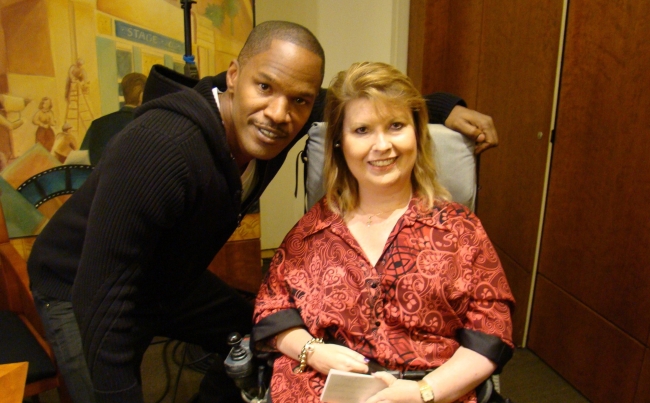Director eyes Hollywood’s portrayal of the disabled in ‘CinemAbility’
By Claire LeePublished : Dec. 6, 2013 - 19:52

A movie inspired veteran director Jenni Gold to seek a life in Hollywood behind the camera.
“Tom McBride played a guy, confined to a wheelchair, in ‘Friday the 13th Part 2,” Gold says. “As a kid, what stood out to me was he was just like me, in a wheelchair. A guy who liked to hang out with his friends. I thought, ‘That’s AWESOME.’ He wasn’t some stereotype, the saintly guy or the bitter guy. He isn’t treated special. It’s ‘Friday the 13th.’ He gets killed like everybody else!”
Such characters, the “mainstreamed” disabled, have been rare in movies and on TV. Gold realized that when she set out to document Hollywood’s history of portraying the disabled on the screen with her new documentary, “CinemAbility.” Tracking down clips of film and TV shows, interviewing scores of actors, actresses, disabled filmmakers and advocates for the disabled for the film, was a real education for Gold, 48, who has been in a wheelchair since she was 7 because of muscular dystrophy.
“CinemAbility” reveals that decades of progress might have peaked with the 1989 release of “Born on the Fourth of July” and “My Left Foot,” portrayals that advocates see as pivotal in efforts to pass the Americans with Disabilities Act in 1990. But while making “CinemAbility,” Gold got plenty of reminders that her documentary ― which is earning comparisons to “The Celluloid Closet,” about decades of Hollywood stereotyping of homosexuals ― is a necessary history lesson.
“I was flipping through the channels one Saturday afternoon, and I stumbled across this Hallmark Channel movie, ‘After the Fall’ (2010),” she says. “It was about a woman (Andrea Bowen) who starts her life over after being paralyzed from falling off her horse. She’s bitter. She’s thinking about not wanting to live. It was so stereotypical, it was like something from another age. And it was new! It was so bad it motivated me to finish my movie.”
Gold got access to the set, actors and director of the recent acclaimed drama “The Sessions,” about a quadriplegic writer (John Hawkes) who avails himself of the services of a sexual surrogate. She interviewed Beau Bridges from “The Other Side of the Mountain,” Gary Sinise (“Forrest Gump”), filmmakers from “Coming Home,” and others such as the Farrelly brothers and Garry Marshall, who make an effort to include disabled characters in their films to show “they’re just like everybody else.”
And Gold interviewed Martin Norden, a University of Massachusetts Amherst professor and author of 1994’s “Cinema Of Isolation: A History of Physical Disability in the Movies.” Norden defined the stereotypical categories Hollywood has placed the disabled in ― bitter, “angry Captain Ahab types,” who want to avenge themselves on society for their disability or simply want to end their lives, or “sweet innocents ... perfect in every way, except for this disability.”
Making “CinemAbility,” Gold learned that Hollywood has long been conflicted about how to present disability ― realizing how offensive Tod Browning’s “Freaks” (1932) was the moment it was released; creating roles for Susan Peters, a rising starlet of the ’40s who was paralyzed but then continued her career; giving visibility to Harold Russell, who lost his hands training for World War II and who won two Oscars playing a handless vet in “The Best Years of Our Lives” (1946).
Then “An Affair to Remember” (1957) comes along, and there’s Deborah Kerr, hiding her paralysis from Cary Grant.
“The original ‘Ironside” was the real eye-opener for me,” Gold says. “I had no idea that this show, from the ’60s and ’70s, was so far ahead of its time. It was a pivotal portrayal of the disabled. It shocked me how much more realistic it was than any of these depictions that I grew up with in the ’80s. This character (a police chief paralyzed in a shooting) wasn’t bitter about the news he was paralyzed. He just went on with his life. He was mean before, he was mean afterward. Think of how progressive that was for that time.”
Reviews for “CinemAbility” have been good (The Los Angeles Times called it ”Exhaustive and eye-opening“). The film is picking up awards and has qualified for others, and Gold has hopes that some attention for the film ― which toured a few cities this year, thanks to Regal Cinemas ― will lead to a wider release. It’s Gold’s first documentary. Indie features (“Cousin Sarah,” “Ready, Willing & Able”) and TV shows have been the director’s forte before now.
As for herself, Gold ― a Director’s Guild of America member who earned degrees in film and TV production from the University of Central Florida, where the creators of “The Blair Witch Project” were her classmates ― says she’s always considered the fact that she’s a woman director (“Those are STILL rare”) a far bigger barrier to Hollywood success than being in a wheelchair.
“My director’s chair goes 12 miles an hour. I can move from one set up to the next quicker than anybody.”
By Roger Moore, McClatchy-Tribune News Service
(MCT Information Services)
“Tom McBride played a guy, confined to a wheelchair, in ‘Friday the 13th Part 2,” Gold says. “As a kid, what stood out to me was he was just like me, in a wheelchair. A guy who liked to hang out with his friends. I thought, ‘That’s AWESOME.’ He wasn’t some stereotype, the saintly guy or the bitter guy. He isn’t treated special. It’s ‘Friday the 13th.’ He gets killed like everybody else!”
Such characters, the “mainstreamed” disabled, have been rare in movies and on TV. Gold realized that when she set out to document Hollywood’s history of portraying the disabled on the screen with her new documentary, “CinemAbility.” Tracking down clips of film and TV shows, interviewing scores of actors, actresses, disabled filmmakers and advocates for the disabled for the film, was a real education for Gold, 48, who has been in a wheelchair since she was 7 because of muscular dystrophy.
“CinemAbility” reveals that decades of progress might have peaked with the 1989 release of “Born on the Fourth of July” and “My Left Foot,” portrayals that advocates see as pivotal in efforts to pass the Americans with Disabilities Act in 1990. But while making “CinemAbility,” Gold got plenty of reminders that her documentary ― which is earning comparisons to “The Celluloid Closet,” about decades of Hollywood stereotyping of homosexuals ― is a necessary history lesson.
“I was flipping through the channels one Saturday afternoon, and I stumbled across this Hallmark Channel movie, ‘After the Fall’ (2010),” she says. “It was about a woman (Andrea Bowen) who starts her life over after being paralyzed from falling off her horse. She’s bitter. She’s thinking about not wanting to live. It was so stereotypical, it was like something from another age. And it was new! It was so bad it motivated me to finish my movie.”
Gold got access to the set, actors and director of the recent acclaimed drama “The Sessions,” about a quadriplegic writer (John Hawkes) who avails himself of the services of a sexual surrogate. She interviewed Beau Bridges from “The Other Side of the Mountain,” Gary Sinise (“Forrest Gump”), filmmakers from “Coming Home,” and others such as the Farrelly brothers and Garry Marshall, who make an effort to include disabled characters in their films to show “they’re just like everybody else.”
And Gold interviewed Martin Norden, a University of Massachusetts Amherst professor and author of 1994’s “Cinema Of Isolation: A History of Physical Disability in the Movies.” Norden defined the stereotypical categories Hollywood has placed the disabled in ― bitter, “angry Captain Ahab types,” who want to avenge themselves on society for their disability or simply want to end their lives, or “sweet innocents ... perfect in every way, except for this disability.”
Making “CinemAbility,” Gold learned that Hollywood has long been conflicted about how to present disability ― realizing how offensive Tod Browning’s “Freaks” (1932) was the moment it was released; creating roles for Susan Peters, a rising starlet of the ’40s who was paralyzed but then continued her career; giving visibility to Harold Russell, who lost his hands training for World War II and who won two Oscars playing a handless vet in “The Best Years of Our Lives” (1946).
Then “An Affair to Remember” (1957) comes along, and there’s Deborah Kerr, hiding her paralysis from Cary Grant.
“The original ‘Ironside” was the real eye-opener for me,” Gold says. “I had no idea that this show, from the ’60s and ’70s, was so far ahead of its time. It was a pivotal portrayal of the disabled. It shocked me how much more realistic it was than any of these depictions that I grew up with in the ’80s. This character (a police chief paralyzed in a shooting) wasn’t bitter about the news he was paralyzed. He just went on with his life. He was mean before, he was mean afterward. Think of how progressive that was for that time.”
Reviews for “CinemAbility” have been good (The Los Angeles Times called it ”Exhaustive and eye-opening“). The film is picking up awards and has qualified for others, and Gold has hopes that some attention for the film ― which toured a few cities this year, thanks to Regal Cinemas ― will lead to a wider release. It’s Gold’s first documentary. Indie features (“Cousin Sarah,” “Ready, Willing & Able”) and TV shows have been the director’s forte before now.
As for herself, Gold ― a Director’s Guild of America member who earned degrees in film and TV production from the University of Central Florida, where the creators of “The Blair Witch Project” were her classmates ― says she’s always considered the fact that she’s a woman director (“Those are STILL rare”) a far bigger barrier to Hollywood success than being in a wheelchair.
“My director’s chair goes 12 miles an hour. I can move from one set up to the next quicker than anybody.”
By Roger Moore, McClatchy-Tribune News Service
(MCT Information Services)




![[Weekender] How DDP emerged as an icon of Seoul](http://res.heraldm.com/phpwas/restmb_idxmake.php?idx=644&simg=/content/image/2024/04/25/20240425050915_0.jpg&u=)



![[Music in drama] An ode to childhood trauma](http://res.heraldm.com/phpwas/restmb_idxmake.php?idx=644&simg=/content/image/2024/04/25/20240425050929_0.jpg&u=)








![[Herald Interview] Mistakes turn into blessings in street performance, director says](http://res.heraldm.com/phpwas/restmb_idxmake.php?idx=652&simg=/content/image/2024/04/28/20240428050150_0.jpg&u=20240428174656)
